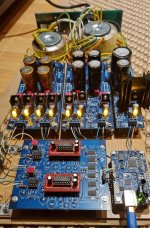After two failed attempts with the SMD PCM1702U and two refunds, and wasting time, the DIP16 version of the PCM1702-K (from ebay seller Polida) worked with the PCM63 adapter. Pictured is @djmilicic DAC Miro PCM63 working with PCM1702. We will tell you later how it plays compared to PCM63. 🤣
Attachments
Too much for me. Not because I can't buy but because I don't want to. And many say that 1702 sounds better.
I'm not that much of an audiophile, I admit. 🤣
I'm not that much of an audiophile, I admit. 🤣
Some say PCM56 is best.
https://www.diyaudio.com/community/threads/new-dac-measurement.49778/
Everyone to his own taste. 😉
Patrick
https://www.diyaudio.com/community/threads/new-dac-measurement.49778/
Everyone to his own taste. 😉
Patrick
Some like brunettes and some like blondes 🙂Everyone to his own taste.
P.S. As for me, PCM56 and 58 are better than 170x, but 1862 is better than PCM.
Alex.
Maybe you should also measure a PCM56K with your modern ADC, to compare apple to apple ?
🙂
Patrick
🙂
Patrick
I don't have one and it would not be apple to apple as PCM56 is 16-bit. Based on the datasheet PCM56K would be typically about 15dB worse. Bernhard hand-picked the best from among 50 samples.
I always liked them in that order : tda1541A (of a late year) , ad1862 , PCM56...
But finally it's all about what you listen to :
with that song all my dac chips are like... vomiting :
But finally it's all about what you listen to :
with that song all my dac chips are like... vomiting :
Last edited:
Someone asked whether the 27R passive IV with AD797 can be used directly on the Miro opamp socket.
In principle yes, but you might need to either move some caps to the bottom, or do some filing on the PCB, or both.
The circuit is the same as the one tested by Fran, but the PCB layout is not tested.
Fran will double check when he has time, before we post Gerber.
You can the order together with your next batch of PCBs.
Size is 12x12x1mm.

The opamp footprint is SOIC8 single opamp.
So you can also use others, such as OPA1611, LT1028, etc.
Some cost much less than the AD797 but not as low noise / distortion.
And you MUST remove the original Riv / Civ.
Cheers,
Patrick
In principle yes, but you might need to either move some caps to the bottom, or do some filing on the PCB, or both.
The circuit is the same as the one tested by Fran, but the PCB layout is not tested.
Fran will double check when he has time, before we post Gerber.
You can the order together with your next batch of PCBs.
Size is 12x12x1mm.
The opamp footprint is SOIC8 single opamp.
So you can also use others, such as OPA1611, LT1028, etc.
Some cost much less than the AD797 but not as low noise / distortion.
And you MUST remove the original Riv / Civ.
Cheers,
Patrick
I have not included a Civ here.
But one can be soldered directly at the DIP8 socket between Pin 2 & 3.
Patrick
But one can be soldered directly at the DIP8 socket between Pin 2 & 3.
Patrick
What's Civ for again? I know it creates the low pass filter but is it for the IV stage itself, the downstream equipment, etc.? I've seen varying corner frequencies for different DAC chips too.
Isn't that one really succeptable to rf, where jan didden and walt jung gave up on it.Some cost much less than the AD797 but not as low noise / distortion.
You mean this :
https://www.diyaudio.com/community/threads/opa1611-opa1641-dangerous-failures.394933/
At least I have used many OPA1641 before without issues.
OPA1611 I admit to have no experience, as I use AD797 instead.
But you can choose any low noise, low distortion opamp with Gain = 100 and in SOIC-8 package.
Someone even suggested NE5534 !!
https://sound-au.com/project187.htm
Patrick
https://www.diyaudio.com/community/threads/opa1611-opa1641-dangerous-failures.394933/
At least I have used many OPA1641 before without issues.
OPA1611 I admit to have no experience, as I use AD797 instead.
But you can choose any low noise, low distortion opamp with Gain = 100 and in SOIC-8 package.
Someone even suggested NE5534 !!
https://sound-au.com/project187.htm
Patrick
- Home
- Source & Line
- Digital Line Level
- DAC AD1862: Almost THT, I2S input, NOS, R-2R


